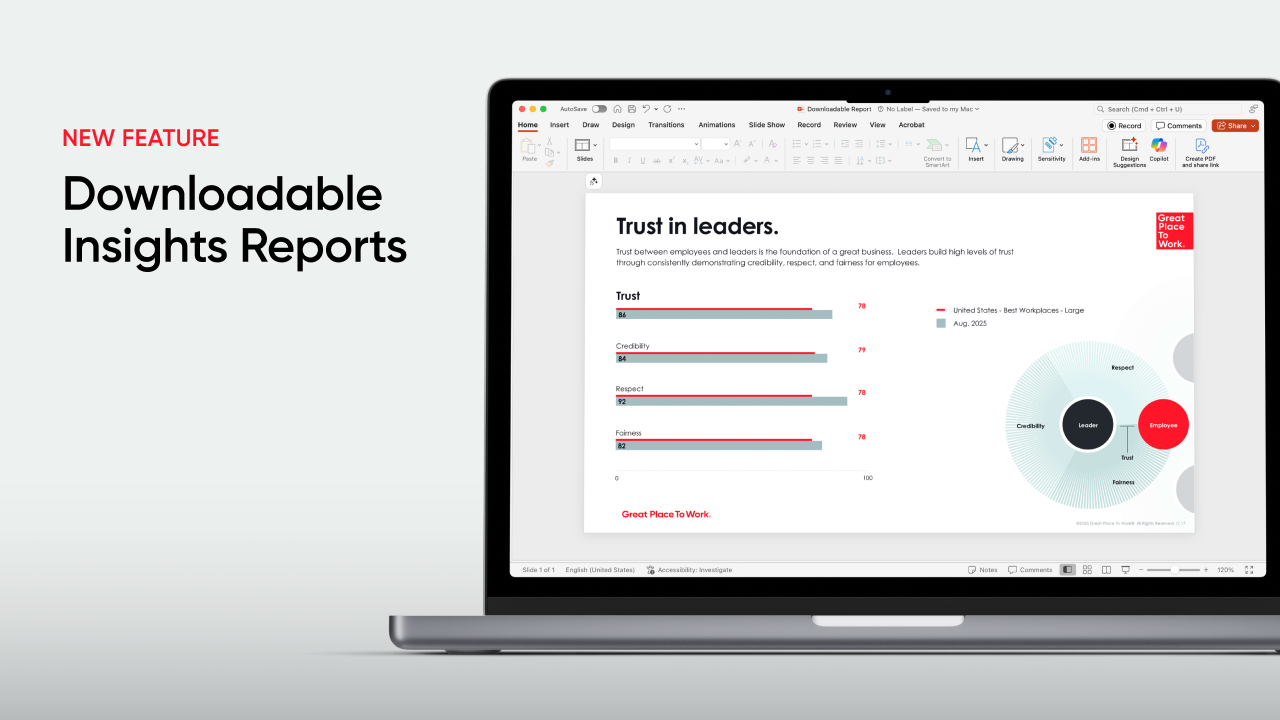Leadership & Management, Managers
Change doesn’t succeed because of strategy alone—it succeeds because people trust the process and the people leading it.
Organizations that lead with trust fuel resilience and alignment, making it the most powerful lever for navigating uncertainty and driving lasting cultural change.
That statement is as true for organizations as it is for people.
Whether it’s a shifting economy, changes in law, or navigating a merger, businesses constantly face change. It’s these organizations and their people that can meet such challenges head on, adapt, and continue to thrive. That continued success hinges on effective change management.
When organizations are agile, it drives cultural transformation and improves business performance. Great workplaces understand this. Employees on the 2025 Fortune 100 Best Companies to Work For® List are extremely agile.
The result is that, on average, the 100 Best Companies earn 8.5 times more revenue per employee (RPE) than the U.S. public market RPE.
Leaders play a key role in guiding their team through effective change management. Here’s how great workplaces have centered change around employee care.
What is change management?
Change management is the process of guiding a business through a major change to its organization, such as layoffs, integrating new tech systems, or changes in HR policies, such as return to premises. This structured process requires people managers and project managers to work together through three key phases: preparation, implementation, and follow-through.
Effective change management supports employees as they adapt to change and continue to drive organizational success. Organizational change management typically falls into two categories: adaptive or transformational.
- Adaptive changes — These are small, incremental changes that an organization will undertake to fine-tune or evolve its existing products, company culture, or workflows over time. These changes are driven by managers and typically don’t impact the organization as a whole. Restructuring your marketing team for improved workflow or introducing new technology to enhance collaboration between remote team members are examples of adaptive change.
- Transformational changes — These changes are much larger in scope and often signify a dramatic evolution in an organization’s culture, structure, or strategy. The need for transformational change may be triggered by external factors, such as in response to economic conditions or a shift in cultural norms that influence the business. Merging with another company or expanding an e-commerce store by opening brick-and-mortar locations are examples of transformational change.
Why is change management important?
Change, even when it’s a good thing, can be messy. This is where clear change management processes come in. When organizations take a people-centric approach to change, it helps minimize disruption, facilitates a smooth transition, and supports individuals as they adopt new ways of working.
Fostering a culture of embracing change benefits more than a business’s bottom line:
- Smoother transitions — Change management facilitates smoother transitions by providing a structured road map for how new ways of working or new technology will be implemented, while minimizing disruption and people’s natural resistance to change.
- Increased employee buy-in — When employees understand the rationale behind changes and the benefits, they’re more likely to be open to adopting innovative processes.
- Improved outcomes — Effective change management helps boost operational efficiency, reduce costs, and enhance business performance.
- Enhanced adaptability and resilience — When change is well-managed, employees build trust in the process. This sets the tone for a company culture that fosters adaptability and resilience.
Aspects of change management
Aspects of change management
Knowing how to lead and manage your people through upheaval is vital to the success of an organization. Successful change management relies on clear communication as leaders and employees navigate the process:
- Leadership commitment — For change management to be successful, leaders play a key role in guiding employees and helping them connect to purpose, so everyone is aligned with the new direction. Our research shows that middle managers play an outsized role in whether companies see the benefits of embracing purpose. Great workplaces spend resources to make sure managers have the skills they need to lead their teams, especially through times of change.
At DHL Supply Chain, more than 9,000 frontline leaders were given communications training to help managers develop the skills to communicate strategy and business priorities. Leaders who participated reported that it helped them understand how to make topics across the business accessible and relevant to their teams. - Clear communication — Your organization’s vision for change should be clearly communicated to every employee, so they know what is expected of them and how the change management process will impact their role. Communication not only builds trust, but speaking is one of the nine leadership behaviors that Great Place To Work® recommends leaders follow.
At DHL Express, the company introduced a social intranet tool called Smart Connect, offering a one-stop shop where employees can find relevant news, strategic updates from management, HR documents and information, a job portal, and more. - Employee involvement — Bringing employees into the change management process helps boost psychological safety in the workplace. Without it, new processes and procedures may be thwarted.
At The Wonderful Company, the “Way of Work (WOW)” program exemplifies how employee involvement can drive successful change. By training all employees — from agriculture to manufacturing to business roles — in continuous improvement practices, the company empowered them to identify and implement changes directly. By giving employees ownership over how work evolves, WOW fostered a culture where change is not only accepted but actively shaped by those closest to the work. - Training and support — Employee training and development equips people with the tools and strategies needed to adapt to change. Training not only gives employees a sense of ownership in their role and a future vision with the organization, but it’s critical for implementing new technology as part of the change management process.
When Adobe introduced AI to the workplace, it also created “AI@Adobe,” a cross-functional working group to promote, govern, and support employee efforts to implement generative AI into workflows, educate on the complex issues around generative AI, and help teams learn from each other. - Monitoring and adjustment — While a well-defined strategy is crucial for effective change management, it’s equally important to monitor and adjust the strategy to ensure its long-term success. Transformational changes especially can take a long time to implement, and it’s difficult to account for every step.
Use a variety of methods to gather insights, revisit your change management plan, and make adjustments accordingly. Leverage employee listening, such as pulse surveys or feedback sessions, to uncover employee sentiment and identify areas for improvement — then act on the results.
Bestop, a leader in Jeep and truck accessories, has grown tremendously with multiple acquisitions, increasing from 100 to 500 employees and introducing leadership changes. For any company, this kind of change comes with growing pains. The company turned to Great Place To Work’s Trust Index™ Survey to pinpoint issues and get a baseline on employee experience.
“While employees never doubted our intentions, we lost our way in a few areas,” explains Haley Van Es, marketing communications specialist at Bestop. Through surveying its people and implementing actionable insights to navigate the path forward, Bestop reset itself as an employee-first company.
Change management in action: Examples from great workplaces
Here’s how great workplaces have successfully guided their people through change thoughtfully:
How WP Engine rolled out pay transparency
Changes in laws around pay transparency meant organizations had to quickly adjust how they communicated compensation.
Tech firm WP Engine responded to this change by relying on tools like Pave to educate their employees about the full value of their compensation, from base pay to incentives and stock.
Priya Bhavsar, senior director of total rewards for WP Engine, explained that part of the change management process also involved offering managers guidance on:
- How pay practices work
- Overall compensation philosophy
- How pay is determined
- How to make pay decisions
- How to navigate pay conversations
However, this wasn’t a quick process. The journey to pay transparency had many stages and took 18 months of behind-the-scenes work.
The results went beyond complying with pay transparency laws. “We’re having greater transparency on where we are as a company, what our business results are, and what our goals are,” says Bhavsar.
How Marriott International increased access to training for its Frontline workforce
Learning and development opportunities are a key differentiator between a typical workplace and a great workplace. Marriott International, a perennial honoree on the 100 Best list, took steps to ensure its global frontline workforce didn’t miss out when it came to accessing to training opportunities.
Here’s how Marriott made training accessible to frontline workers:
- Honor time constraints with relevant material — Frontline workers often face severe time constraints, particularly when working hourly roles. Marriott ensured learning programs targeted at frontline workers were fit-to-purpose and digestible. Jessica Lee, vice president of global talent development, recommends that people have the time to focus on learning if they want to make a leap forward.
- Don’t overlook basic skills — When considering what training to offer frontline employees, don’t forget to offer foundational skills. Even training on basic workplace software like Microsoft Office tools can make a profound difference.
- Build listening channels to meet the specific needs of the frontline — How do you know which training will make an impact on your workforce? Ask your employees. Make sure you get real-time feedback through focus groups and employee surveys.
- Challenge assumptions about who can offer an important lesson to others — Important lessons can come from surprising places. In the case of Marriott, one of the most important lessons came from a co-worker who didn’t come from a prestigious university but instead had experience in the housekeeping department. For training managers, it was a reminder that great teachers come from all backgrounds.
- Lean into digital tools to meet employees where they are — For organizations that struggle with taking frontline employees off the floor for training and learning programs, digital tools are crucial. For Marriott, with its large international footprint, this meant providing an experience that reaches employees where they are in a language that they understand.
How Camden Property Trust communicated workforce changes to its staff
Seeking employee input when making the tough decision to restructure or conduct a layoff can be daunting for business leaders.
Camden Property Trust, No. 18 on the 100 Best Companies list in 2025, met the challenge by keeping employees informed and engaged throughout the process.
In the face of change, it’s important to acknowledge that leaders don’t have all the answers, says Allison Dunavant, VP, organizational development. However, a commitment to deep listening opened new doors for Camden during the restructuring process.
“We recognized that with massive change, we weren’t going to get everything right,” Dunavant says. The only way to identify missteps was to engage with people at all levels for feedback.
Camden established working groups that involved all levels of employees to help solve issues that were important to them and important to the business. These working groups were so successful that the organization kept them even after completing its restructuring.
When companies commit to listening while trying to reshape their workforce, the benefits go far beyond employee goodwill. For Camden, engaging its employees to build a better workplace is a core part of its strategy to drive business results.
How Tofurky rebuilt trust after an acquisition
How can leaders rebuild trust with employees after major changes? That was the challenge facing plant-based meat producer Tofurky after being acquired by Morinaga Nutritional Foods.
Understandably, employees were uncertain about their future. Jeff Schulkers, chief operating officer, was part of the management team that spearheaded efforts to transform the company. Schulkers started by listening to employees to understand what was working well — and what wasn’t.
Trust Index Survey results offered quantitative feedback that illuminated clear opportunities. From there, they identified changes to make, redefined roles and responsibilities, increased communication between leaders and the frontline, and brought in new leaders.
Here’s how Tofurky transformed its culture:
- Redefining roles and responsibilities — Tofurky knew it needed to engage the frontline to recalibrate its culture. Tofurky’s operations leaders threw out the old playbook to redefine roles.
- Two-way communication with the frontline — One of the first changes was to ensure that frontline workers felt they had a voice and were included in strategic decisions. The team created multiple efforts to bring employees together and communicate top priorities and initiatives for the business.
- Making leaders approachable — Changing company culture starts with showing a high level of care for workers in the organization, something that Tofurky prioritized. Approachability can take many forms. When Estela Caballero, people partner for the production operations team, dressed as a hot dog for a town hall event, it signaled that she was someone people could talk to about their concerns. A more direct option was sharing a senior leader’s phone number with employees by posting it all around the manufacturing building.
- Measuring impact — Tofurky’s leaders have a clear set of KPIs to understand how the employee experience drives business results. Other metrics included “lagging indicators” like turnover and “leading indicators” like stay interviews.
The results speak for themselves, as Tofurky earned Great Place To Work Certification™ for the first time in May of 2024, with 87% of employees saying the company is a great place to work.
Overcoming common change management challenges
Navigating change can be challenging. Here are some typical obstacles to change management that organizations can face and strategies to address them.
Resistance to change — Any change initiative is going to encounter resistance. Employees may fear the unknown or perceive changes to ways of working as a threat. Others may disagree with initiatives or worry they’ll be laid off in the process. Fear and uncertainty are common human reactions to change, and unless leaders address people’s concerns, resistance can thwart change management.
The solution? Make change with employees, not to them. Assess how the change initiative will impact employees, so you can address their concerns from the start. Explain the why, so employees understand the rationale behind change management and how it will benefit the organization and their role. Create psychological safety, so people feel comfortable enough to share their ideas, questions, or concerns.
Lack of clear communication — When information isn’t shared clearly, confusion, resistance, and the failure of a project are likely results. It isn’t enough to communicate change processes at the onset; great leaders understand they should communicate clearly, transparently, and often.
Be prepared to repeat information throughout the entire process and with every employee impacted. For transformation change, this means reaching everyone from frontline workers to remote employees. Use multiple communication channels to provide consistent and regular updates.
Insufficient resources or support — When businesses undertake a large-scale transformation, research shows their efforts fail about 70 percent of the time. One reason is insufficient resources and support, which leads to delays and missed efficiency gains. It can also lead to a lack of employee buy-in and further resistance to change.
Organizations need to ensure there is adequate resourcing to facilitate transformation, including comprehensive plans that include timelines and resource allocation. Leaders also play a role in fostering a supportive environment and listening to employees’ concerns. Listening not only strengthens relationships, but it can also help drive innovation — an important ingredient in effective change management.
Failure to sustain changes long-term — Innovative ways of working can take time to stick. Without reinforcing change practices, employees can revert to old ways of working and resist embracing future change initiatives. Failure to sustain change long-term can also impact a company’s bottom line from decreased productivity and missed efficiency gains.
The solution: Build in short- and medium-range wins along the way. Celebrating is another high-trust leadership behavior that can build or break trust in the workplace. Recognition in the workplace helps employees see that their company values them and their contributions, fostering loyalty and engagement. A genuine “thank you” from those in the corner offices can ignite a 69% increase in the likelihood of employees bringing their extra effort to the work floor.
Tools and techniques for successful change management
ith the right tools and techniques, organizations can meet the challenges that come with change management head-on.
Digital tools offer ways to communicate, track progress, and manage the change. These tools range from simple project management software to platforms designed specifically for complex change management.
Employee surveys are invaluable in navigating complex changes. Here’s why:
- Informing strategic decisions — Survey feedback guides leadership’s decisions during uncertainty.
- Unmasking hidden concerns — Surveys illuminate concerns about job security, work-life balance, and adapting to new technologies during uncertain times.
- Encouraging innovation and adaptability — Surveys help uncover creative ideas, process improvements, and solutions to current challenges. Employees on the front lines often have insights that leadership may not see.
- Supporting change management — Surveys provide insight into any resistance to change, supporting effective management strategies.
- Strengthening communication — Surveys are two-way channels between management and staff, facilitating better understanding.
- Building trust — Seeking feedback, sharing the results, and acting on that feedback rebuilds trust during periods of instability.
As well as employee surveys, leaders can enhance listening and build trust by:
- Using employee resource groups (ERGs) and committees
- Offering opportunities to engage through multiple channels, such as town halls, pulse surveys, or internal messaging systems
- Ensuring authentic follow-up on employee feedback
With the right tools in place, leaders will be well-positioned to listen to employees and guide change initiatives.
Create a change-ready culture
Great workplaces demonstrate how effective change management practices can foster a more adaptable and resilient organization.
However, building a change-ready culture requires trust, effective communication, and employee empowerment. Leaders play a key role in centering change around transparency and considering the needs and concerns of their people. That starts with listening.
Regular surveys provide leaders with the real-time insights needed to keep change management practices on track. Great Place To Work’s employee survey solutions can empower organizations to navigate change with confidence and build a resilient, high-trust culture.
Transform your workplace culture today.
Turn culture insights into business wins
Let the Trust Index™ Survey reveal your workplace’s hidden strengths and areas for growth. Start transforming today.











